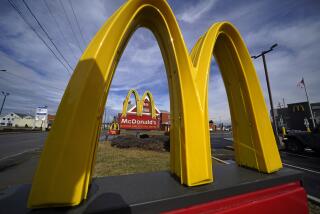The culprit in a cookie dough E. coli outbreak could be raw flour
- Share via
An investigation of a 2009 outbreak of E. coli traced back to raw cookie dough finds the culprit may be raw flour.
A report released Friday in the journal Clinical Infectious Diseases provides the details of the analysis, from the first outbreaks of E. coli to interviewing patients to tracking the illnesses to raw cookie dough and trying to determine which ingredient cause the illnesses. In all, 77 patients from 30 states were affected; 35 people were hospitalized but there were no deaths.
In May 2009 a foodborne disease surveillance system found a 17-case cluster of E. coli infections in 13 states, prompting an investigation by the Centers for Disease Control and Prevention and local public health officials. To help pinpoint the cause of the outbreak the patients were matched with controls who had non-E. coli intestinal illnesses such as salmonella. Patients were interviewed and answered questionnaires about foods they had recently eaten.
Among the foods eaten frequently were strawberries, ground beef, poultry, apples, leafy greens--and raw, pre-packaged cookie dough. Studying 36 patients and 36 controls from 18 states, researchers found that eating a particular brand of cookie dough was the only thing significantly linked to illness. Although not named in the study, news reports at the time identified Nestle Toll House cookie dough.
After some cookie dough product samples turned up positive for E. coli after testing there was a voluntary recall.
But what ingredient in the dough was to blame for the outbreak and how did it become contaminated? Despite investigations and testing, that’s still not known. After ruling out the likelihood of being caused by factors such as food handling, safety violations or intentional contamination, the study authors considered ingredients like molasses, unpasteurized eggs, sugar, margarine, chocolate chips and baking soda. But each of those was also ruled out.
That pretty much left flour, which, the authors noted, is a raw product. Although no conclusive evidence was found to pin the illnesses on flour, they made the case that flour is purchased in large quantities and could have been distributed to a number of lots. Also, it’s not processed to kill pathogens.
“Consumption of cookie dough,” the authors wrote, “appears to be a popular practice, especially among adolescent females.” Need some proof of that? Among the patients who contracted E. coli from eating cookie dough, 66% were under 19 years old, 71% were female, and some told investigators they bought the stuff never intending to bake it.
So let’s review: Don’t eat raw cookie dough. The study noted that several cookie dough manufacturers told the FDA they started using heat-treated flour, and suggested all companies consider making their product safe to be eaten raw. Because we all know people are going to do it anyway.






